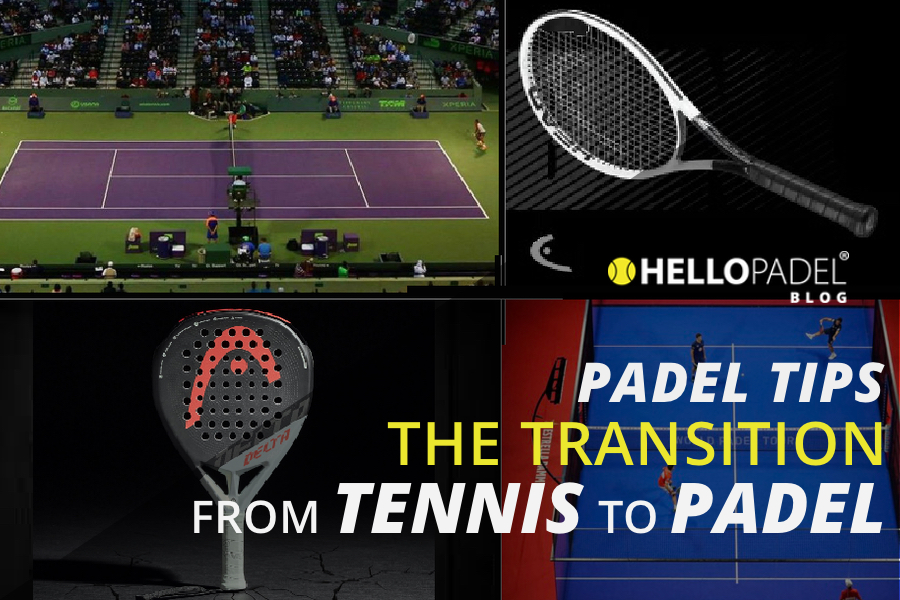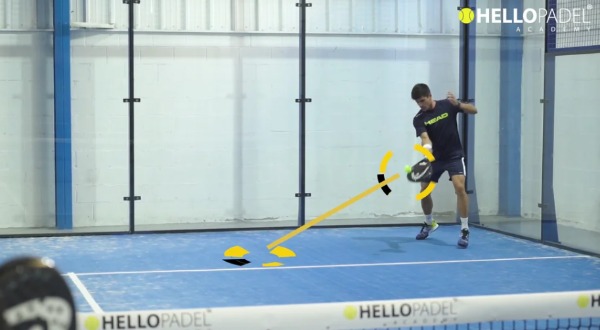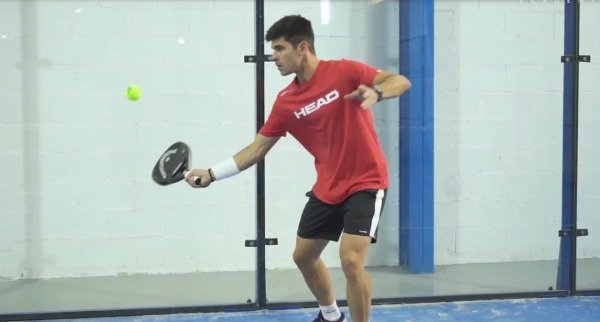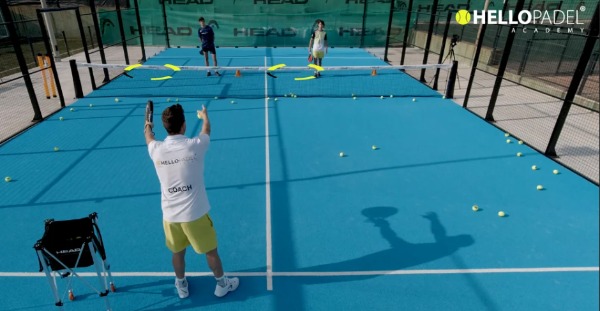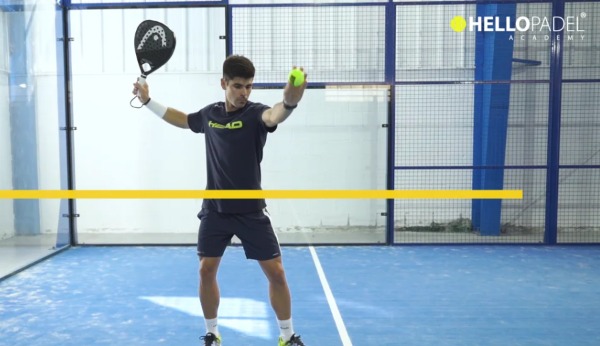1. INTRODUCTION – FROM TENNIS TO PADEL
We are sure we are not wrong if we say that, nowadays, there are many players who play padel who came from tennis. And we ask ourselves, is there anyone who does not know a padel player who came from tennis?
For these players, it is clear that they started playing padel , with a good grounding and with some advantage and level compared to those who started playing without having picked up a racket before, because they usually already have a good volley, good touch and ball control, know the grips, will learn more quickly the proper technique of padel, body movements, etc..
However, these have also dragged with them certain vices or errors, since, although tennis and padel have some strokes in common, tactically they are very different and in padel we also have the walls to contend with!
So, in this article we will see some tips for padel players who come from tennis to improve and rectify some of the typical mistakes they may possibly make.
2. MISTAKES AND TIPS FOR PLAYERS MAKING THE TRANSITION
1. Forget about power shots.
One of our goals when we play padel would be to try to make the opponent always hit the ball from below the net height, and us always above. Therefore, using strong strokes in padel, normally, is not only not advisable, but also, on many occasions, will make the ball bounce too much and remain very high, so we will be giving the opponent the opportunity to counter attack us. Many times it will be more effective to make a slower or softer shot, looking for the ball to die off a wall and not bounce, and thus, make the counter shot much more difficult for our rivals.
2. Forget about topspin shots.
In padel, generally speaking, we should not use topspin strokes. Any topspin will make the ball rise, both when it bounces on the ground and when it bounces off the wall, leaving an easier ball for the opponent. It is better to use flat or slice shots to try to get the ball to rise up as little as possible.
Perhaps, the only exceptions to use the top spin would be when we seek to make a touch shot, or return to the feet, or when hitting the ball with the aim to bring it back to our side of the court or take it out x3.
3. Learn to work the point more and be more patient.
In tennis, especially if you are serving, it is likely that you can often win the point relatively quickly by serving well, hitting a few good shots and finishing the point at the net or by forcing an error. The tennis player’s attitude is often very aggressive and clearly characterised by seeking to win the point in possibly only a few strokes.
On the contrary, in padel, it is very unusual to win a point with just a few strokes, especially as the level of the players increases.
That’s why, when we play padel, we have to be and play much more patiently than in tennis, because finishing a point is much more difficult. Players who come from tennis have to change the psychological-tactical mind set that they had of always being aggressive and playing with powerful strokes, to the mind set of being patient and working a lot on the point until they get a ball, to finish the point definitively.
4. Try to make fewer definitive smashes.
It is very common to see, whenever they get a lob, whether it is easy or not, how many players who come from tennis always try to hit very strong smashes to finish the point as they did when they played tennis. It is normal, since in tennis they won the point most of the time.
However, in padel, leaving aside the professional players, who are at a different level, we rarely manage to finish the point with a strong smash. In padel we should not try to win every ball that is hit to us from above. If we tried to do this with every lob, we would lose a lot more points than we would win.
Often it is better to hit a less powerful and well placed smash with a good spin (or a bandeja/vibora), than a very powerful and flat smash, as the opponent can intercept this more easily.
5. Learn the bandeja and the víbora.
This point is linked to the previous point. In padel, when we are hit with a lob or a high ball, in the vast majority of occasions it will be more effective to perform a bandeja or a víbora than to try to look for a winning smash.
Therefore, learning how to do, above all, the bandeja, should be a priority for players who come from tennis.
6. Use the walls.
It is also very typical to see how players who come from tennis and have only recently started playing padel don’t use the walls at all. If they are at the back, all the balls that come, whether they are fast and deep, they will play them directly without letting them bounce off the glass. They will even volley from the back of the court before letting the ball bounce off the glass. This, in padel, is a mistake and something that must change.
The walls are not our enemies, but we have to know them and know how to make them work in our favour and not against us.
7. Hit a lot more lobs.
In tennis, you rarely use the lob when your opponent goes up to the net. Most of the time you opt for a passing shot, as the tennis court is big and the player will never be able to cover the whole court. But in padel, it’s a different story. The court is much smaller, there are walls that make the balls bounce back into play and we always play doubles, so getting a passing shot is almost impossible. That’s why in padel we hit a lot of lobs, with the aim of sending our opponents to the back and gaining the net, which is where we win the points and the matches.
8. Be prepared to switch between attack and defence very often.
In tennis, usually, when one of the players takes the initiative, they keep it until they win the point, force the opponent to make a mistake or make an error themselves.Rarely is there a change of role within the same point.
In padel, on the other hand, it is very typical to see both partners switch from attacking to defending several times within the same point before one of them manages to win it.
9. Play more in the middle.
In tennis, you always try to play to the sides and open up angles to make your opponent run, tire him out and force him to make a mistake. It’s logical, the court is much bigger and you have to run a lot to get to the ball. But in padel, the game is not like that. As there are walls, the ball will always bounce and return into the court. For this reason, sometimes it is more effective to hit the ball to the centre, as this way we get both players to move towards the middle, generating gaps on the sides, and at the same time there is a chance (in less experienced pairings) that the opponents are not sure whose ball it is.
10. Go to the net more.
In tennis, many points are won from the baseline (perhaps grass court tournaments are the exception). In padel, it is more difficult to win a point from the baseline. That’s why, as soon as you have the opportunity, you have to go up to the net, which is where you win most points and matches.
11. Do ”slice” volleys and not always strong.
In padel, we are rarely going to be able to win a point with a power volley. Most of the time we will have to play a volley that is not very strong, with a short spin and looking for it to hardly bounce and rise from the glass to make it as difficult as possible for our opponent to return it.
12. Think and play in pairs.
Although doubles exist in tennis, the reality is that most matches and tournaments are singles. In padel, directly, singles matches do not exist (at least not officially). This means that we must always play with our partner in mind and follow a tactic accepted by both of us,as well as moving well together.
13. Learn to play without a ball.
In padel, it’s quite common to “FREEZE OUT” a player. This basically means that you deliberately decide not to hit the ball to a specific player. If in a match our opponents freeze us out, meaning that the ball is not hit to us, we must learn to play without the ball. This means staying focused and alert during a point, informing my partner of what the opponents are doing, trying to intercept when the opportunity arises or make it look like we are doing it to create uncertainty or generate a mistake for the opponent, staying involved in the match…
This situation, in tennis, is going to happen much less often and only in doubles,of course.
14. More forward and backward movements.
In tennis, the vast majority of movements that a player makes are lateral. On the other hand, in padel, although there are also lateral movements, there are also many forward and backward movements, because of the rebounds on the back court glass and because one of the objectives is to win the net (point 8) whenever possible.
15. You have to move as a couple.
In padel, it is very important that the couple moves in unison throughout the different situations in which we can find ourselves within the same point, for example, when going up to the net, when going back to the back court because we have been passed, when moving to the corresponding side when we are at the net to cover the centre and the parallel…
16. Shorter racket preparations and follow through.
It is very important to make, above all, a much shorter stroke preparation than in tennis. We play on a much smaller court and, therefore, it is not at all necessary to make a long preparation. Moreover, we have already seen that hitting hard will often work against us.
On top of that, by doing a short preparation, we are ready earlier, it will give us much more ball control and it will help us to hit the ball in front of the body.
17. Serve less fast.
In tennis, the vast majority of first serves are about power over other objectives. To give us an idea, the fastest serve is by Sam Groth, who served at 263 km/h (seriously!) at the Busan Challenger in 2012. This is logical because a good first serve in tennis can give us, or almost give us, direct points.
In padel, the purpose of the serve changes completely. Obviously, to begin with, it is no longer even possible to get close to the serving speeds that are achieved in tennis because you have to serve from the maximum height of the waist. But leaving aside the issue of the rules, serving very fast in padel is not always going to give us more advantages. On the contrary, serving faster in padel will give us less control of the direction of the ball, more chances to miss and less time to get to the net.
Therefore, many times we will benefit more from a low serve with a slice spin so that the ball is not lifted, and a medium speed (giving us a chance to be near the net before the opponent returns), rather than a more powerful serve.
Furthermore, even if we manage to hit a very fast and well placed serve, the opponent will almost certainly be able to return it as he can always let the ball pass and wait for it to bounce on the glass. And if you need convincing of this, look at professional padel to see how many points you see won with the serve or if the pros always serve very strong.
3.CONCLUSION
No one disputes that tennis players who play padel already have an advantage over those who have never played tennis before.
However, we have also seen that these players tend to carry several ”bad habits” when playing padel. Therefore, it is not at all strange to see how, in padel, a “100%” padel couple with poor technique is able to beat a couple of very good tennis players, through their knowledge of the game of padel and it’s tactics…
We would also like to clarify that, the tips and mistakes we have seen in this article, are not exclusive only to players who come from tennis, but are applicable to all players. Any player can also make these mistakes, even if they have never played tennis before.
What about you, are you a padel player coming from tennis and do you make any of these mistakes?
LEARN TO MASTER THE GAME OF PADEL: HERE
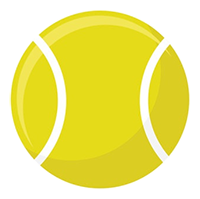 Upgrade now
Upgrade now




